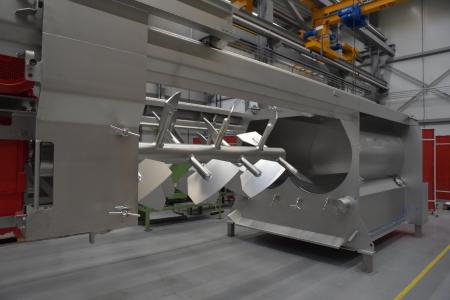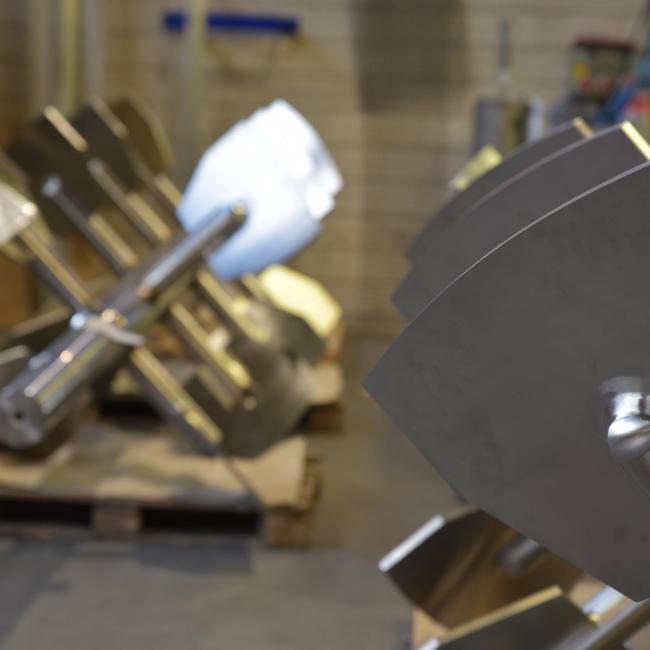This article discusses factors to consider when designing open process equipment such as:
- Influence of environmental conditions on the preparation of foods
- Choice of material
- Cleanable surfaces
- Hygienic connections
The experts at Dinnissen Process Technology are available to answer all your questions!
Get in touch with Juul Jenneskens 077 467 3555
Influence of environmental conditions on the preparation of foods
The environmental conditions play an important role in the preparation of food in an open process. With an open process there is a greater chance of contamination as soon as micro-organisms occur in the environment. It is important in which phase of the process the contamination occurred and of what type and degree the contamination is. Different hygienic requirements can be set for each phase. For example, some raw products need to be heat treated, unlike consumer goods which should not be exposed to excessively high temperatures.
Many different types of equipment are used in open processes. This concerns, for example, machines for dairy products, coffee products, sugar, vegetables, fruit, meat and fish. Under no circumstances should the design of any kind of machine cause an increase in micro-organisms. The hygiene and cleanability of the equipment is crucial. In order to ensure optimal hygiene and cleanability, the design must choose the right materials, surfaces that are easy to clean and hygienic connections.

Hygienic design
Choice of material
Materials that come into contact with foodstuffs must always, that is at any pressure and temperature, be inert, mechanically stable and non-toxic. In addition, they must be resistant to the product, but also to all cleaning and antimicrobial agents in any concentration. Stainless steel meets all these requirements and is therefore the most widely used material in the food industry. However, the corrosive properties of both the products and the cleaning agents must always be taken into account. No problems due to corrosion should arise in welding either. Aluminum is not suitable as a material that can come into contact with foodstuffs because of the risk of corrosion.
Plastics are mainly used in the equipment to protect tools so that two metals do not come into contact with each other. This can be the case with knives. In addition, plastic is also used for lids, guides and pipes because of its flexibility and corrosion resistance. However, not all plastics are suitable. Some plastics are porous, which means they can absorb components of products and retain microorganisms.
If the equipment has a top layer of nickel or chrome, that layer should never flake, as this can cause contamination. In that regard, it is better to use chemically treated materials than galvanized materials. Namely, chemically treated materials are more durable and their coating layers have a greater compactness and density. Which coatings can best be used differs per application. It depends on the corrosion resistance in combination with the properties of the product and the cleaning agents.
Cleanable surfaces
Hygiene is very important in the food industry. Therefore, all surfaces that come into contact with the food must be easy to clean. The surfaces must therefore be completely smooth. Smooth means, free from cracks or other minor damage in which dirt can remain. The surface roughness of stainless steel may not exceed 0.8 μm Ra over the life of the machine.

Stainless steel suitable for food-grade requirements
Materials that come into contact with foodstuffs must always, i.e. at any pressure and temperature, be inert, mechanically stable and non-toxic
Hygienic connections
Connections are preferably welded and cannot be disassembled. Welded seams must therefore be ground flat and polished smooth because of the hygiene risks. Welding errors can cause microbial problems and should therefore be avoided as much as possible. Examples of common welding errors are:
- Porosity,
- Inclusions,
- Rip,
- Incorrect alignment.
In addition, welded connections must not overlap. Dirt can build up in overlapping welded joints. In addition, they are difficult to clean. If an overlap is necessary, the shadow areas must be able to drain well and be cleaned. If thick plates are welded together, the edge of the top plate must be chamfered and, if necessary, reground. In addition, there should be as little welding work in sharp corners as possible, because these are also difficult to clean. Instead, rounded corners and welds can be made on the straight surface. Ideally, the weld surface is therefore completely smooth, without interruptions and overlaps. The welds must be welded in one piece to avoid gaps where there is metal-metal contact.
Demountable connections should be avoided as much as possible. Compared to fixed connections, they have greater hygiene risks, such as edges, protruding parts and recesses where dirt can remain. Removable connections such as plates that are attached with screws or bolts should therefore be used as little as possible, unless there is no other option and disassembly is necessary. With overlapping screw connections, the ends of the metal-metal contact surfaces with overlapping edges must be well sealed. Account must be taken of the extra space that the seal needs to expand in the event of heat. This is best done with bolts or pins. Threads are not suitable for this because of the clearance. Threads may also not appear on the product surface. Threads can cause danger through metal-metal contact. In the design, they must therefore be placed on a side where no product comes into contact with it. If screw connections on the product side are unavoidable, bad screws and nuts must always be avoided there. These can create slots and crevices, which is detrimental to hygiene. However, if the button head of a screw connection is exposed, it can be cleaned properly. Other risks can possibly be avoided by welding a bolt on the non-product side. In addition, flange-type screw connections are most suitable in this case, as they directly affect the compression of the seal.
In short, when it comes to demountable connections, good design has:
- shielded threads,
- flange plates with sealed edges,
- screw heads or nuts suitable for mechanical cleaning,
- elastomer gaskets with a metal back to avoid metal-metal contact.

Name: Juul Jenneskens
Advisor
Please feel free to contact me if you have any questions about this subject. My team of colleagues and I are ready to answer!
Get in touch with Juul Jenneskens 077 467 3555 [email protected]
Do you prefer to request a consultation directly?
